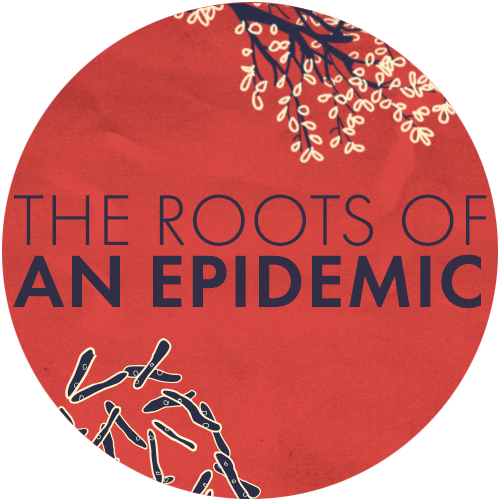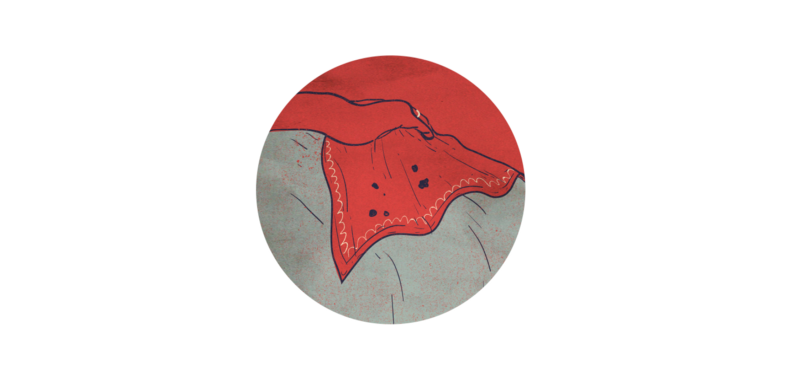

Read the next installment: “How Gender Affects the Global Tuberculosis Epidemic“
Read the previous installment: “We Need More Than Technology to Eliminate Tuberculosis“

When Amina started a new job that involved searching for undetected cases of tuberculosis in her community, she did not expect that the first case she detected would be herself. The 38-year-old mother of three (whose name has been changed for this piece) lives in the town of Kahama, in northern Tanzania. She had been coughing for weeks prior to her diagnosis and had visited several health facilities, but she was given regular antibiotics, which are ineffective against TB.
Around the same time, she was hired as a community health worker with SHDEPHA+Kahama, the local branch of an organization that provides various health and social services, including TB screening. (SHDEPHA is an acronym for Service, Health, and Development for People living with HIV/AIDS.) During Amina’s onboarding, she learned more about TB symptoms, and soon realized that they matched her own. She took a sputum sample to the nearby hospital for a TB test.
When the results came back positive, Amina refused to accept them, daunted by the emotional, social, and financial implications of being diagnosed with TB. She traveled to a different hospital, about four hours away, for a second test. After another positive result, Amina accepted her diagnosis and resolved to start treatment.
The simplest TB treatment regimen has not changed for a half-century, in large part because TB is not considered a lucrative investment for pharmaceutical research. Patients must take frequent doses of four different anti-mycobacterial medicines over the course of 180 days. To ensure that patients adhere to this regimen, most TB treatment guidelines are based on directly observed therapy, or DOT, which requires that each one of these dozens of doses be taken under the direct observation of a responsible adult.
Amina was given a choice: visit the clinic every day for DOT, or do it at home. Home DOT would require that her husband, as the other responsible adult in the household, accompany her to the clinic for an initial visit and commit to being her treatment observer. They would then be given a month’s supply of treatment for Amina to take at home, under his observation. But her husband’s initial reaction to her diagnosis was far from supportive.
“He wanted to divorce me,” Amina says. “But in the end, he accepted my result on the condition that I have to be tested for HIV.” People living with HIV are more than 15 times as likely to get active TB, so the two illnesses are often associated with each other. Amina and her husband each got an HIV test, and when their results came back negative, he decided against divorcing her–though he still refused to be her home DOT observer.
But Amina knew a way to convince him. “After telling him that he has to give me bus fare every day so that I can go and take the pills at the hospital,” she explains, “he thought of the daily expenses and he agreed to go with me to the hospital to take the medicines and be my daily supervisor at home.”
Finally, several months after her illness began, Amina could start anti-TB treatment. She completed the six-month course under the observation of her husband–who she says has since become caring and supportive–and was cured of TB.

Amina has continued working with SHDEPHA. Her duties include visiting households in her community to educate people about TB, screening them for symptoms of the disease, and, if they exhibit these symptoms, collecting sputum samples, which are sent to a lab for testing. Amina and numerous other community health workers function as critical links in public health systems’ severely constrained infrastructure, meeting people where they are.
Amina’s work also brings her into contact with women who are going through experiences similar to hers, stretching her role beyond simple TB screener to counselor and confidant. When one client’s husband was abusing the woman following her TB diagnosis, Amina helped the patient return to her family home in a different town, where she was able to access treatment.
Another woman Amina visited had signs of TB, and agreed to provide sputum samples for herself and all household members. But when Amina returned the next morning to collect the samples, she met resistance. “The husband was at home and was furious with the woman and myself for even daring to think that his family could have TB,” she says. “That man chased me away and I was never again able to check the TB status of the family.”

It is scientifically proven that patriarchy shoots everyone in the foot. Last month, one of the world’s top medical journals, The Lancet, published an issue on women in medicine, science, and global health. The lead editorial borrowed the title of bell hooks’s pivotal book Feminism Is for Everybody, and opened with a direct quote from her first book, Ain’t I a Woman: “To be “‘feminist’ in any authentic sense of the term is to want for all people, female and male, liberation from sexist role patterns, domination, and oppression.”
The issue went on to present, in a series of extensively researched articles, scientific evidence on how the universal realities of sexism have shaped health care at all levels. Authors offered academic arguments for what health care systems need to do in response, such as building a feminist global health agenda, or applying feminist theory to medical education.
The journal’s adamantly feminist approach was both unusual and welcome in a field that has historically been–and remains–steeped in patriarchy. As some authors acknowledged, the stiff frameworks of science and global health policy are ill-equipped to address the core of the problem: a deeply rooted worldwide culture of sexism, which lives in the fluid complexities of the everyday.

Health programming is, by necessity, data-driven, in order to enable (in theory, at least) the continual assessment and optimization of services, and to promote accountability. Numbers help determine how resources should be allocated–including which groups are considered “vulnerable”–and figures are used to assess whether or not interventions are working. On the surface, the data-driven approach has an inherent objectiveness–but in reality, decisions about what data is collected and how it is interpreted are very much subject to individual and systemic bias.
As the Lancet editorial explained, “reflecting on [gender] biases can be difficult for professions like science and medicine that are grounded in beliefs of their own objectivity and evidence-driven thinking.” The fragmented nature of health funding and programming further complicates this reflection. A cross-cutting issue like gender–which tends to be conflated with “women’s issues,” despite impacting people of all genders–is often considered from the limited perspective of how it affects the epidemiology of specific diseases.
TB is an illustrative example of the problems that sort of perspective can create. Globally, there are twice as many cases in men as in women; men have more exposure to key risk factors, like occupational hazards or smoking, and they are less likely to seek medical help for their symptoms. It is unquestionably important to understand and respond to the specific challenges faced by men in relation to TB–some of which, like avoiding treatment, are linked to patriarchal notions of masculinity. But this acknowledgement is sometimes extended to suggest that since men are more heavily affected by TB, the specific challenges faced by women warrant less concern.
Of course, such compartmentalization only makes sense in theory. The “sexist role patterns, domination, and oppression” that feminism resists run deeper than epidemiological curves. And as people’s lived experiences show, data frameworks are not always able to capture the damaging effects.

As part of its TB outreach, SHDEPHA conducts community dialogues in public spaces where men tend to congregate. These dialogues, says SHDEPHA’s Rabia Khaji, have repeatedly exposed the sexist views that men hold toward women with TB. “You hear the men saying, “‘If I was the one, if it was my wife with TB, I would just chase away the woman,'” Khaji explains.
Some of these attitudes stem from a general fear of transmission, which can be diminished by teaching community members that TB patients quickly become noninfectious after starting treatment. But there’s no denying that women are stigmatized particularly harshly. When Amina thinks about the backlash from family and neighbors that followed her TB diagnosis, she says, “This could have been a different case if it was a man. The community couldn’t have pointed fingers at a man.”
Her comments are echoed by research conducted in multiple countries across the world, which found that “women were particularly vulnerable and fearful of abuse, abandonment, divorce and other marriage-related problems” associated with a positive TB diagnosis.
In some settings, this stigma is connected to the relationship between TB and infertility, a link that is poorly understood but recognized as a growing problem requiring more attention from the reproductive health field. TB can appear anywhere in the body, including in the genitourinary tract, which includes the uterus. Genital TB often presents with nondescript symptoms, like irregular menstrual cycles and cramps, which many health care workers are not likely to associate with tuberculosis. In addition to a lack of awareness, many facilities lack the infrastructure needed to diagnose genital TB, rendering this sub-epidemic largely invisible in routine program data.
The evidence that we do have–from research studies, case reports, and anecdotal information–points to a serious problem. Female genital TB is thought to account for up to 16 percent of infertility in developing countries, particularly those with a high prevalence of tuberculosis. In one analysis of the case records of women diagnosed with infertility in India, nearly 49 percent of those whose infertility was due specifically to obstruction in the fallopian tubes were found to have genital TB. In some places with a high prevalence of TB, people’s experiences–which carry more weight in the real world than the best-researched scientific papers–have led to the belief that women who get TB will not be able to bear children later in life.

Among the places where this belief contributes to social stigma is Afghanistan, according to the Afghan Community Research and Empowerment Organization for Development, or ACREOD, a collective of doctors working to improve TB detection and treatment in Kabul. In contrast to global trends, more women in Afghanistan have TB than men, a disparity that has been linked to socioeconomic factors that make women more vulnerable. The demographic TB distribution here looks very different from that of Tanzania, where disease rates are higher in men–but women in both countries must navigate similar challenges related to patriarchal restrictions on their freedom.
For example, as one nationwide study pointed out, in some parts of Afghanistan women are mostly confined to their households, where poor ventilation can lead to the rapid spread of TB. As default caretakers, women are also likely to be more exposed to any family member with the disease. Doctors from ACREOD have further observed that because women are often the last to consume the food they themselves prepared for the household, they tend to have poorer nutritional status, which is one of the biggest risk factors for contracting tuberculosis.
In Afghanistan, 42 percent of households report that at least one family member was married before the age of 18–a statistic that signals another risk factor for TB. Early marriage can lead to earlier childbirth and shorter intervals between pregnancies, and pregnancy itself is associated with immunological changes that make women more vulnerable to TB. Even in low-prevalence locations, like the U.K., TB risk has been found to be significantly higher during the postpartum period. In turn, multiple studies have shown that rates of complications and mortality are higher in pregnant women with TB and their newborns.
Part of ACREOD’s work in Kabul focuses on integrating TB into OB-GYN services, by conducting screenings for all women diagnosed with infertility. Since local facilities lack the advanced laboratory services needed to diagnose genitourinary TB, the organization has also been trying out a simpler diagnostic method using widely available tools. If successful, innovations like this (which, like Shdepha’s TB activities, are supported by TB Reach, a global funding mechanism for innovative TB programs), may help to uncover the true extent of genital TB and related infertility in women. This could in turn make the case for more systematic diagnosis and treatment for affected women.

ACREOD also collaborates with a network of female private practitioners to integrate routine TB screening, diagnosis, and treatment into their services. According to the doctors’ observation, many patients’ families prefer that female members be treated by female doctors.
In Tanzania, the health care workers at SHDEPHA also say that patients tend to prefer female clinicians–they’re perceived to provide better services. “This work of caring for people has tended to be seen as women’s work rather than men’s work,” Rabia Khaji says. “Men think they are better and more busy than women, but women are actually doing more, at work but also in their homes and the community.”
Women around the world carry an invisible burden of labor, and this is particularly true in health care. Over the past decade, due in part to lessons from the HIV epidemic, there has been a rise in the number of community health workers like Amina, who are increasingly filling in the gaps that public health systems lack the resources to address. These workers are mostly women, and while they play a critical role in the health system, they are often classified as volunteers–they receive minimal compensation for their work, if they are paid at all.
Women who support family members with TB get even less recognition. Researchers who talked with miners and their families in South Africa found that “some [men] reported self-delaying access to TB care; others were eventually dragged to a clinic by their wives or transported by ambulance because their illness had progressed so far that they collapsed.” After diagnosis, wives are often the ones who serve as primary caregivers, but many women “reported that neither the mining companies nor local health facilities provided them with TB information.” One miner’s widow told researchers, “The nurses and doctors would never explain anything to us, we would be excluded from the consultation.”
This dismissiveness toward women is not limited to caregivers. Research in multiple countries–including studies specifically on TB–has found that female patients are less likely to have their symptoms taken seriously. Across the world, the clinical health workforce itself is clearly skewed: nursing roles are largely occupied by women, while men dominate leadership positions. This imbalance is driven by deeper social factors, such as gender stereotypes that cast women as natural nurturers and men as leaders, as well as by inequities in access to education.
Medical education itself, as Canadian physician Malika Sharma points out in the Lancet, tends to promote a logic rooted in patriarchal values such as rationalism, distance, and the perception of patients as passive objects. This breeds paternalistic, rather than compassionate, approaches to patient care–which in the case of TB have gone as far as having law enforcement authorities confine drug-resistant TB patients, against their will, in “prison-like” facilities.

These and other injustices–which extend far beyond patient-related challenges, including biases and the underrepresentation of women in medical research, as well as the discrimination and harassment of women in health institutions–have long been recognized, both by scientists and by the feminist movement. Feminists have played a significant role in championing women’s right to access quality health care–for example, by pushing for better gynecological services in South Africa, and by leading research and advocacy efforts for reproductive health and rights in Uganda.
Today, the wider feminist movement is once again shifting the ways that the medical field approaches gender. While improving the health of women and girls has long been explicitly highlighted as a global priority–see the United Nations’ Sustainable Development Goals as well as their predecessors, the Millennium Development Goals–the past few years have seen an increase in calls to examine the underlying structures that make women and girls vulnerable in the first place.
Health professionals are also acknowledging the way that the #MeToo movement has recently intensified global consciousness and created a sense of urgency around gender injustices. The ripple effect in health care has fueled dissatisfaction with incremental changes–like gender quotas that focus only on increasing the number of women in certain roles–and encouraged demands for deeper systemic change.

At the institutional level, medical education and research need to be reformed in order to secure the inclusion of more women and of more feminist theories and methodologies. Systemic change also means fixing gender policies in the health workplace–including accountability mechanisms to ensure that they are upheld. In its 2019 report, the policy and advocacy organization Global Health 50/50 writes that, while the past two years have seen a significant increase in the number of health institutions publicly committed to gender equality, many still fail to “walk the talk.”
It’s harder to monitor the progress of gender equity in the patient-care setting, which is often highly context-specific. Over the past 30 years, there has been a substantial increase in the number of clinical and public health programs reporting sex-differentiated data, which can lead to more tailored and effective interventions. But it’s difficult for the prevailing data frameworks to capture the more nuanced gender challenges that overlay biological sex–and they tend to adhere to cisnormative male/female binaries, both reflecting and reinforcing queerphobic mindsets (which are themselves rooted in patriarchy).
There’s no scientific solution for curing patriarchal mindsets. There has been considerable progress on policies and reforms that address the intersections between gender and health, but it’s often limited to mitigating the symptoms of sexism, rather than tackling its roots. These roots, as experience with TB shows us, can influence patient outcomes, regardless of how any particular disease is distributed across the sexes. The answers seem to lie more in the work done by community-based groups, like SHDEPHA, which actively challenge the underlying culture of patriarchy through direct engagement with people on the ground.
Such engagement, while very different from the biomedical interventions that have classically been associated with health responses, is the most critical requirement for a lasting shift from “gender-blind” to “gender-responsive” health systems. The understanding that global health problems need political solutions is not limited to macro systems–it also includes the politics of the everyday. Addressing the intersection between gender and health care, therefore, must begin with the deeply personal work of unlearning and resisting patriarchal norms.
This article was amended at the request of the Stop TB Secretariat to identify ACREOD and Shdepha as TB Reach grantees.

Read the next installment: “How Gender Affects the Global Tuberculosis Epidemic“
Read the previous installment: “We Need More Than Technology to Eliminate Tuberculosis“

How We Get To Next was a magazine that explored the future of science, technology, and culture from 2014 to 2019. The Roots of an Epidemic is a four-part series on tuberculosis, the leading cause of death from an infectious agent around the world.
